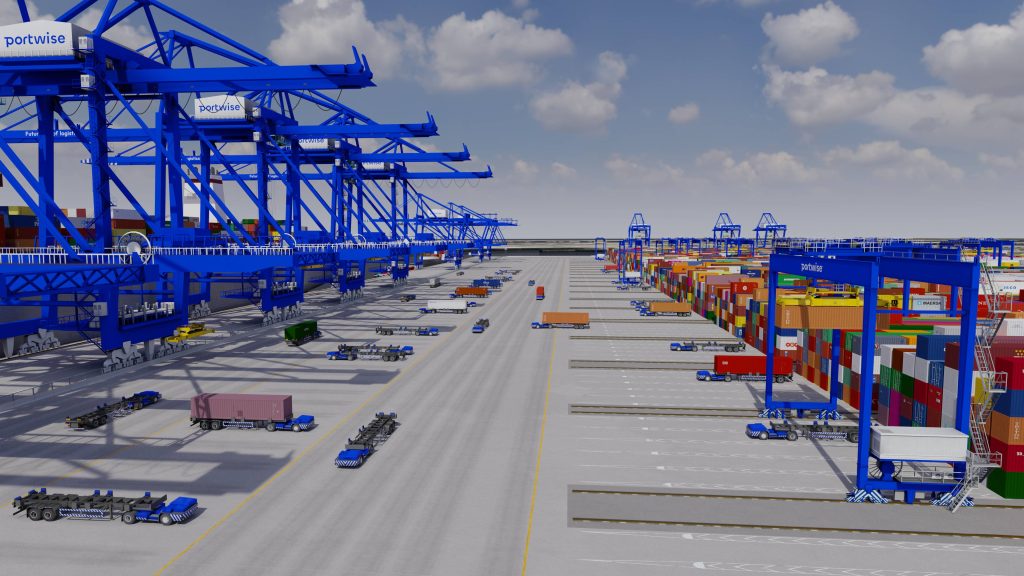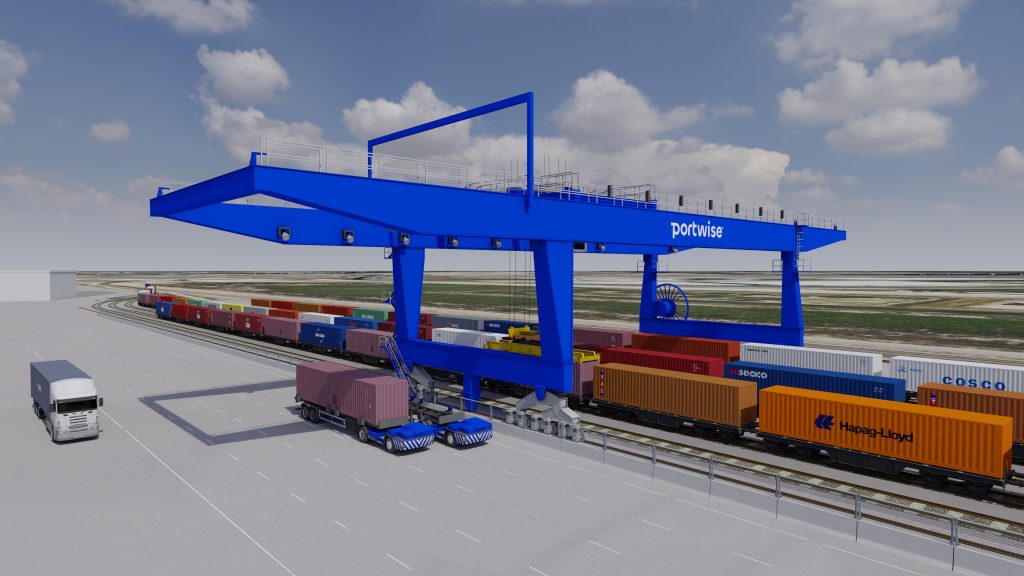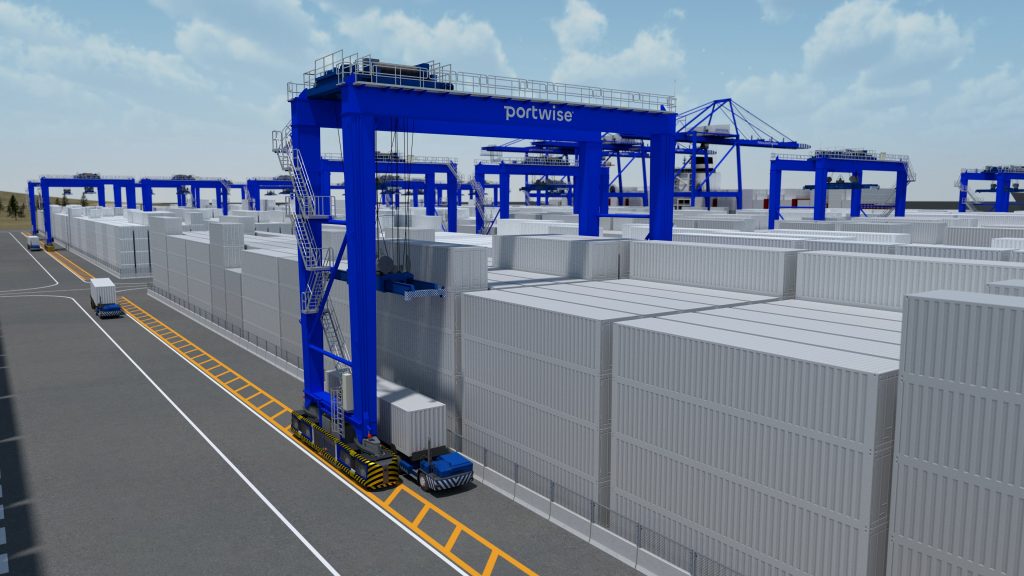Autonomous vehicles – the holy grail?
In the container industry, automated transport has been successfully embraced by many terminals worldwide since 1993. Under virtually all circumstances, a fleet of Automated Guided Vehicles (AGVs) is carrying out the heavy duty of transporting containers to and from the vessels.
What this application does not resolve, is a mixture of manned and unmanned traffic. This may not be required for these types of terminals, but it is required for other common terminal operation environments including the bread-and-butter terminal equipped with Rubber-Tyred Gantry cranes (RTGs) and terminal trucks (TTs), maritime yard and rail yard container transfer, intermodal operation, etc.
To allow for mixing of manned and unmanned traffic, developments on autonomous transport (including live pilots) are ongoing for various types of operations. Different strategies are chosen by the key players with some focusing on teleoperation (as opposed to autonomy), varying autonomy levels between central fleet management system vs. vehicle itself, navigation reliance solely via sensors/cameras on vehicles or still with support via extra fixed infrastructure installed in surroundings or beacons.
The status quo: technology is developing quickly – but the use case applications and business viability are still unclear.
Despite all these efforts and rapid progress, the current developments are far from level 5 automation (or even level 4). The path towards large-scale implementations in daily terminal operations is still faced with many challenges to solve. While technology readiness (driving and safety) is certainly one fundamental pillar, two other critical prerequisites for future large adoption of autonomous solutions exist:
- Capability for various daily operational container terminal use cases
- Business case viability of a fleet of vehicles
Most developments of autonomous vehicles are still in the general/early stage focusing on safety and vehicle driving – e.g. obstacles/moving objects detection and avoidances, vehicle routing and stopping/driving, safe container handover with other equipment. However important they are, these do not (yet) check off all the essential elements needed for efficient and reliable large-scale terminal operation – e.g. how sequences for loading should be managed, interactions in a dynamic equipment environment including just-in-time delivery at quay cranes for loading, how the traffic rules/right of ways should be prioritised between manual and autonomous trucks.
Although there are some basic business case demonstrations available that argue the obvious benefits of reducing manpower by using automated trucks, there is a lack of in-depth quantification, especially regarding the performance impact. Therefore, a comprehensive business case is missing that takes into account a fleet of vehicles and a system perspective for the various types of terminals in our industry, as well as the different operational scenarios. Arguments applicable to an RTG – TT terminal can be different for TTs for container transfer between rail terminal and Automated Stacking Cranes (ASC) yard. Application for a transshipment site could require alternative strategies compared to a gateway site with heavy local traffic. Also, the question is not just whether to replace manual trucks with autonomous trucks but can well be why not to choose other more proven concepts over the still early-stage autonomous technologies.
While technology readiness is being addressed with tremendous efforts from various suppliers, in-depth attention to these two other pillars is still lacking. Wishful thoughts and qualitative statements are just too general and not yet convincing enough. To bridge the gap from a terminal operation perspective, we also started looking into these two topics. Our approach is to first focus on short- to medium-term feasibility and viability for use cases that could be implemented with the current state of development from an operational perspective.
Applying autonomy – four use cases foreseen with most short- to medium-term feasibility and business viability
Below we will discuss four application use cases. We have selected them because we consider them possibly realisable in the short- to medium-term from a technology, regulation, and application perspective, as well as viable from a business-case perspective. Each case still requires a more in-depth business case demonstration (for which case-by-case follow-up publications are planned).
This article intends to provide an introductory overview of these cases highlighting key underlying aspects for their application feasibility and business viability.
- Non-mixed traffic operation
A possibility to run with autonomous TTs in the foreseeable future is by taking baby steps without changing too much on the existing status quo. An example is not to apply autonomy in mixed traffic operation yet, but to implement it as an alternative to AGV operation. For example, autonomous TTs with end-servicing ASCs.
In such a case, only one component of the current proven operations needs to be changed. It allows for gaining experience with autonomous TT operation and TT behaviour. This has a couple of advantages over an AGV system, such as lower pavement requirements and potentially lower CAPEX cost per equipment, which could benefit the business viability. Additionally, if autonomy fails to deliver, a fall-back strategy could be performed towards an AGV-like centralised equipment control system for vehicle routing and transfer point management, while operating the autonomous vehicles.
 Figure 1: Autonomous terminal trucks in a non-mixed traffic operation environment (concept example illustration)
Figure 1: Autonomous terminal trucks in a non-mixed traffic operation environment (concept example illustration)
- Limiting the capabilities of autonomous vehicles
One possibility to enable a mixed-traffic operation in the near future is to limit the capabilities of autonomous vehicles. An application example could be to use autonomous vehicles for rail container transfer for an ASC terminal with a rail terminal at the landside, while the ASC will also serve manned external trucks at landside. Instead of full mixed traffic, the capabilities of autonomous vehicles could be limited via a speed limit, dedicated interchange lanes at the landside ASC, dedicated traffic lanes to minimise traffic interaction points, strict/rigid vehicle routing and right-of-way management at intersections, to manage and achieve the safety requirements.
The downside of these limitations is certainly the performance loss – lower vehicle speed, more vehicle brakes/waiting, longer cycle time, lower vehicle productivity, and less just-in-time delivery. However, such performance loss can often and to a large extent be offset by adding extra vehicles or by preparation/buffering. In our studies, we see that similar or comparable overall operational performance can still be achieved to meet the required operational targets. Then, a comparison can be made between the extra CAPEX (from more expensive and more vehicles), and the OPEX savings in labours that are required for manned vehicles otherwise. Eventually, the OPEX savings could still lead to a viable business case of autonomous application, especially foreseen at sites with high labour costs or scarce labour availability.
 Figure 2: Autonomous terminal trucks serving a rail operation (concept example illustration)
Figure 2: Autonomous terminal trucks serving a rail operation (concept example illustration)
- Human-assisted autonomy (1:1 / 1:N)
Another path with short- to medium-term feasibility and also economic viability is human-assisted autonomy. Autonomy handles parts of the operation, while human control/oversight remains from the central room via teleoperation. Depending on operational situations besides the technology capability and reliability, the man-machine ratio can vary from 1:1 to 1:N (1 teleoperator handles 1 to N vehicles).
The level of human involvement can also range from remote controlling of the entire or part of the process to only overseeing and intervening in case of exceptions or complex decision making. To do this effectively and efficiently, systems need to be in place for smart job selection, equipment assignment and smooth safe hand-over. Such a solution enables different possible N ratios to allow for manning reduction.
The extent of economic viability of such human-assisted autonomy and the varying levels of human involvement would also depend on local labour costs and resources. This solution could already reduce the idle time of vehicles even for the 1:1 case. Hence, a better and safer work environment is achieved, which is more than often considered by terminals as a strong business case driver. Combining human assistance and autonomy could result in a viable safe alternative balancing between performance and operational safety, with near-future applicability particularly to sites such as C-RMG/RTG with typically substantial mixed traffic from an operational perspective.

Figure 3: Autonomous terminal trucks in an RTG operation (concept example illustration)
- Occasions-based autonomy
Finally, occasion-based autonomy could be considered. Several automation projects have already taken this approach, for example by performing housekeeping moves throughout the night, when no external trucks are on site. This provides a more predictable environment to operate autonomous TTs. Despite not adding any productive moves, this operation can enhance operational efficiency throughout the day due to the moves that have been prepared autonomously throughout the night.
Alternatively, one could also look at autonomous operation when the terminal is not busy and when there is less traffic on the terminal, therefore less interaction with external traffic. This can be used in the early stages to decrease OPEX, while the continuous roll-out of autonomous vehicles can be performed on demand. Manual labour could then be used to scale the horizontal transport demands.
Future outlook: still many challenges to face moving forward
The cases (including possible combinations) could easily vary in their feasibility and business viability with different terminal characteristics and operational situations, but the potential of autonomy for selective applications in the near future is certainly there. Yet, we shall still realistically acknowledge the many challenges on its road to large-scale application.
The main challenge certainly still lies in how technology further develops – which underlines all the essences for possible applications and business cases in terms of the needed functions, capabilities, performance, reliability, and safety. But via this article, we want to bring the essential use cases and business viability into the conversation also. We aim to contribute to the further development of autonomy and feedback to the autonomous technology development to gauge where to focus on (more) to move forward, especially in the short- to medium-term.
For each example provided, Portwise will publish separate follow-up white papers to provide more insights with case studies detailing on the scenarios, CAPEX, OPEX and impact on performance.
About the authors:
Dr. Zack Lu works as a Senior Project Manager at Portwise. In the last 11 years, he has worked on various terminal projects related to design, simulations, operation optimisation, automation, etc.
Kaj de Groot works as Director of Automation Projects at Portwise. He has worked in the ports and terminals field for about nine years and has been involved in many different brownfield terminal design and automation transition projects.
This article has been published in PTI Jornal Edition 140